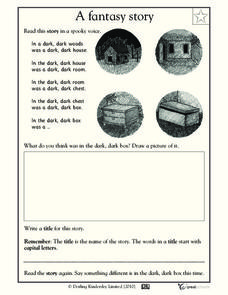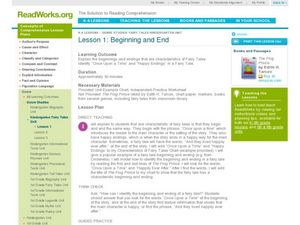Baylor College
Need or Want?
Even as adults it can be hard to distinguish needs from wants. Using pictures of common, everyday items, children make a pocket chart separating the objects they need from those that they want. Discuss their choices, explaining that...
Curated OER
A Fantasy Story: Spooky!
This creepy fantasy story needs an ending! Learners use a spooky voice to read a short story ending at an ellipsis...what was in the dark, dark box? They illustrate what they think could have been in there and write a title for the...
Curated OER
Where and When
Use the pictures from Knuffle Bunny to determine setting with your class. Model your visualization and thinking process, asking questions to help your listeners determine time and place. After reading this story, go through other...
Curated OER
Where
Kindergartners identify where a story takes place. In this literature lesson plan, learners take a picture walk and discuss how pictures can provide clues to the location of the story. They then illustrate where a new story of their own...
Curated OER
Adding to Sorted Groups
First graders sort pictures of animals into categories. In this sorting lesson plan, learners use the book On The Farm to categorize their animals.
Pace University
Community Helpers
Differentiate instruction with a unit focused on community helpers. A pre-assessment levels scholars into three groups. Learning contracts offer participants the choice of activities to complete and show what they know about specific...
Manchester University
Where The Forest Meets The Sea
Join a father and his son as they explore an isolated location off the coast of Australia in the children's book Where the Forest Meets the Sea by Jeannie Baker. Engage young learners in reading this fun story with this series of...
Curated OER
Graphing Memories
Mem Fox’s Wilfrid Gordon McDonald Partridge provides the labels for a graphing activity. Class members create an illustration of a memory item brought from home, and place their illustration in the proper column of a graph. When the...
Curated OER
Lesson 1: Beginning and End
Students study fairy tales. In this fairy tales lesson, students discover beginning and ending phrases characteristic of these types of stories. They listen to their teacher read The Frog Prince, take notice of those familiar phrases,...
Curated OER
Similarities and Differences in a Text
Create a T chart of similarities and differences between the past and present from the story Long Ago and Today. Using their handy T chart, youngsters will chart things that are the same or different today and long ago. They'll draw a...
Curated OER
Short Story
Young scholars draw conclusions from the short story Ssssssilent Hunter and listen to the clues to find out what animal is being described. In this drawing conclusions lesson plan, students explain why they think the animal is what they...
Curated OER
Onomatopoeia
Learners identify onomatopoeia by identifying sound words in a book and drawing the animals that make those sounds. In this onomatopoeia lesson plan, students read the words as if they were the animal indicated.
Curated OER
Step By Step Directions
Perfect for your unit on pumpkins and autumn! Learn how to write step by step directions on how to dry pumpkin seeds based on The Pumpkin Book. Youngesters also explain how they know this is a "how to" book. A fun and yummy lesson plan!
Curated OER
Identifying the Problem in a Story
Model how to identify and describe the problem in a story with Eve Bunting’s My Red Balloon. Then guide your learners through the process with Olivia and the Missing Toy. For independent practice, individuals draw a picture and write a...
Curated OER
Lesson 1: Identifying Information
Factual books about animals are great for sparking interest in non-fiction text. Little ones will love learning about the foods animals eat as they practice identifying facts in a text. They chart the information they've learned by...
Curated OER
Humorous Solutions
Discover with your class the humorous solution that follows tall tales. Elementary learners will discuss the tall tale Paul Bunyan and give ordinary solutions for the problems in the story. They will read Sally Ann Thunder Ann...
Curated OER
Oklahoma Stone Soup
Class members complete activities related to the story "Oklahoma Stone Soup." First, pupils read, discuss, and answer questions about the story. Next, to incorporate math into the lesson, learners make stone soup using a variety of...
Creative Educator
Amazing Animal Alliterations
Creatures can cause creativity! Alliteration can make writing more enjoyable and entertaining. Help your pupils grasp this concept by using animals as inspiration for alliterative sentences. Prepare your class for the activities by first...
Curated OER
Beef or Dairy?
Guernsey, Jersey, Holstein. Brangus, Charoloais, Herford. Here’s a truly cross-curricular resource that combines language arts, science, math, and visual arts activities as class members learn to distinguish between beef and dairy...
Curated OER
Garden Grid
Basically, your class reads about different garden plants from an included handout and seed packets that you provide, and then uses a grid to plan out where to place the plants. They can practice counting with the seeds, grouping,...
Common Sense Media
ABC Searching
Students explore English by completing an interactive computer activity. In this alphabet lesson, students research the Internet to create a picture dictionary which they share with classmates. Students locate digital images of words...
Curated OER
Repeated Text
Students examine repeated text to predict the outcome of a story. In this language arts lesson, students read a story and use the repeated language to make predictions about what will happen next in the story.
Curated OER
Physical Attributes
Practice describing the physical attributes of story characters. After listening to a story, kindergartners identify each of the characters. They then draw a picture of the characters from the book.
Curated OER
Identifying the Problem and the Solution in a Story
Story elements: the problem and the solution. Help your youngsters identify these elements by reading Bringing Down the Moon, by Jonathan Emmett. After a class discussion and chart creation discussing problems and solutions from past...

























